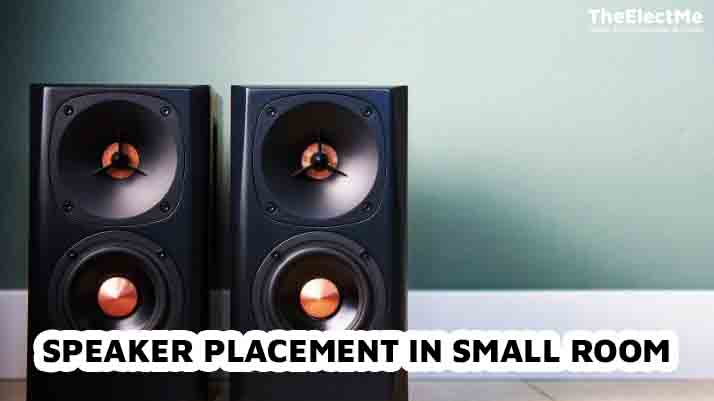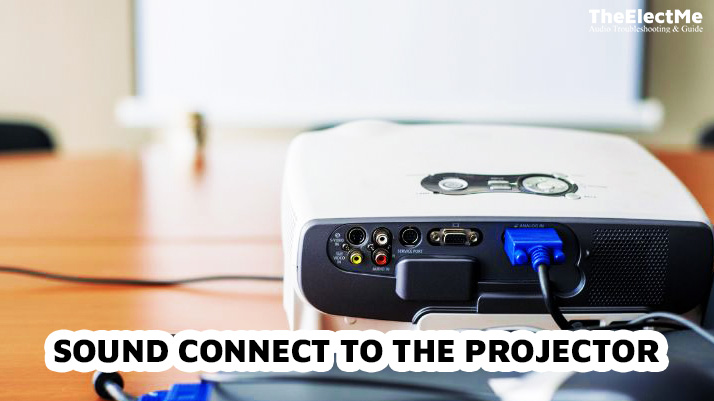Getting the best sound replacement in small room can be challenging. But, with the correct speaker placement, it’s possible. Proper positioning of speakers plays a critical role in creating an immersive audio environment. It helps reduce sound distortions, enhancing audio clarity, and providing an all-around balanced sound.
So, setting up speakers correctly is necessary for a home theater or a hi-fi music system. This guide will walk you through how to do just that. Following these steps, you can optimize your audio setup for a small room, making every listening session enjoyable.

Understanding the Basics of Sound and Room Acoustics
Sound, like light, travels in waves. These waves move at about 1,130 feet per second, bouncing off surfaces and creating echoes and reverberations. This interaction between sound waves and the space around them is what we refer to as acoustics.
The sound behavior in a room is influenced by factors such as room size, construction materials, and objects present.
Sound can travel across open office spaces, causing distractions that can be reduced with insulated walls.
Sound waves travel shorter distances in a small room before they reflect off surfaces, causing significant echo.
Additionally, sound waves interact with each other. Speaker sound waves mixed with surface-reflected waves can enhance or interfere with sound quality. This interaction depends on the timing and direction of these waves.
Understanding these basics of sound and room acoustics is key to setting up speakers correctly in a small room. It helps you anticipate the sound’s behavior and adjust for the best listening experience.
Related: How To Wire Speakers With 4 Terminals?
Speaker Placement In Small Room With Just 5 Steps
How you position your speakers will determine the overall sound quality in a small room. Here are five steps to follow when setting up speakers in a small room for optimal sound.

Step 1: Find the Sweet Spot
The first step to setting up speakers in a small room is determining the best listening position. This is the “sweet spot,” where sound converges from all speakers for the best audio experience.
Typically, the sweet spot is located centrally between the two main speakers and at an equal distance from each. It’s a cozy spot to enjoy your music or movie, like your favorite armchair, couch, or computer desk setup.
Remember, the farther you are from the speakers, the more the sound can spread, improving the stereo image. However, you need to be closer to your speakers in a small room than in a larger space.
Step 2: Apply the Equilateral Triangle Principle
The equilateral triangle principle is a fundamental guideline for speaker placement, especially in small rooms or studio environments. This principle suggests that the listener and the two main speakers should form an equilateral triangle.
This setup ensures simultaneous sound delivery from both speakers for optimal stereo imaging and soundstage. It helps to create a balanced sound field where the left and right channels are equally represented.
To implement this, measure the distance between your chosen listening position and each speaker. Adjust the speakers’ positions until all three triangle sides are equal. Remember that the speakers should ideally be at ear level for the best results.
Step 3: Adjusting Distance from Walls and Corners
Setting the right distance between speakers and walls/corners can significantly affect your listening experience. Placing speakers near walls or corners can cause a boomy or muffled sound by amplifying low frequencies.
Position the speakers about 1/3 to 1/5 the room length from the front wall.
For best placement, center your speakers along the longest room wall, ensuring equal distance to the side walls.
However, these are not strict rules but starting points. You may need to adjust based on your room’s specific acoustics and personal sound preferences. Always trust your ears and adjust accordingly for the best sound quality.
Step 4: Consider Speaker Elevation and Aim
Speaker elevation and aim are critical factors in achieving optimal sound quality. The height of your speakers can significantly impact the soundstage and imaging of your audio setup.
For optimal sound output, position your speakers at ear level when seated in your listening position. High-frequency sounds are best perceived at ear level because they are highly directional. If your speakers’ tweeters aren’t at ear level, adjust their height or tilt them slightly to face your ears directly.
When aiming, the speakers should be pointed towards your listening position. This can enhance the stereo image and make the sound seem more three-dimensional.

Step 5: Test and Fine-Tune
Once your speakers are placed according to the previous steps, it’s crucial to test the sound and fine-tune the placement as needed.
- Play a familiar track: Use a well-known song and listen for clarity, balance, and depth. The audio should sound clear, not muffled or harsh, with an even balance of low, mid, and high frequencies.
- Use a sound level meter: This device can help you ensure each speaker is outputting sound at the same volume, which is crucial for a balanced stereo image.
- Test with different types of audio: Different music, movies, and spoken word genres can highlight other aspects of your audio setup. Test with various audio to ensure your setup sounds great no matter what you’re listening to.
- Adjust and retest: If something doesn’t sound right, make small adjustments to your speaker placement and retest. Adjust speaker position by moving them closer or further from the wall, changing the angle, or adjusting the height.
Remember, the goal is to achieve a sound that pleases your ears. Every room and every listener is unique, so don’t be afraid to trust your instincts and adjust as needed.
In the next section, let’s discuss the special considerations for room dimensions, shape, and acoustics.

Related: What Is A Speaker Management System?
Special Considerations Based on Room Layout
Do you have a small room with unconventional dimensions or unique acoustic properties? Here are some special considerations to consider when setting up your speakers.
Rectangular Rooms
The speakers should ideally face the room’s length for optimal sound in rectangular rooms. Sit in the first third of the room for balanced sound, while the listener occupies the remaining two-thirds.
For ideal speaker placement, create golden rectangles in the rear corners when speakers are positioned along the longer side of the room. Remember to angle the speakers towards the listening position for a focused stereo image.
Irregular Rooms
In irregularly shaped rooms, speaker placement can be more challenging. The general principle remains unchanged: position the speakers to form an equilateral triangle with the listener.
If this isn’t possible, you should experiment with different positions to find the best.
For rooms with asymmetrical layouts, mimic symmetry as much as possible. To maintain sound balance, place furniture and gear evenly throughout the room.
Remember, these are all starting points. Every room and every listener is unique. So don’t be afraid to trust your instincts and adjust as needed.
Final Thoughts – Speaker Placement In Small Room
To summarize, speaker placement in a small room is about balance, symmetry, and trusting your ears. For optimal sound quality, follow the equilateral triangle principle. Adjust the distance from walls and corners, elevation, aim, and test with different audio sources.
Remember to experiment and fine-tune your specific room and personal preferences as needed. Proper placement allows your small room to be an acoustically pleasing listening environment for all audio content. Feel free to test and adjust until you find the perfect setup for your space.



